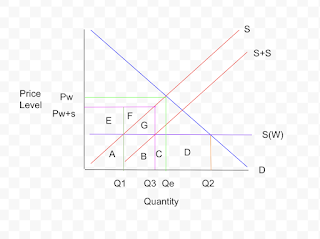Greece: Agriculture Subsidy

Greece has come to an agreement with the EU to provide a 1billion Euro subsidy to Greek farmers and the agriculture sector. Using the graph below, let's say that before the subsidy Q2 amount of agricultural products were being consumed at the price of Pw while domestic production was Q1 and imports were Q1-Q2. However after the subsidy the domestic supply curve was moved to the left becoming S+S. However the demand remains at Q2 and the price at Pw. Now the domestic producers increase their production from Q1 to Q3. This means that they are receiving more revenue. Therefore the subsidy policy is beneficial for the domestic producers. For foreign producers, they are now producing less, from Q3-Q2. This means that they have a fall in their revenues. Thus this policy is detrimental for foreign producers. For domestic consumers, their tax euros are the funding for this large subsidy. To be able to support this large subsidy, the government will most likely need more tax revenue result